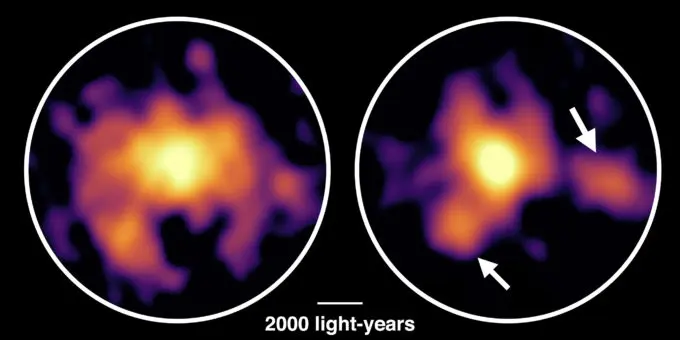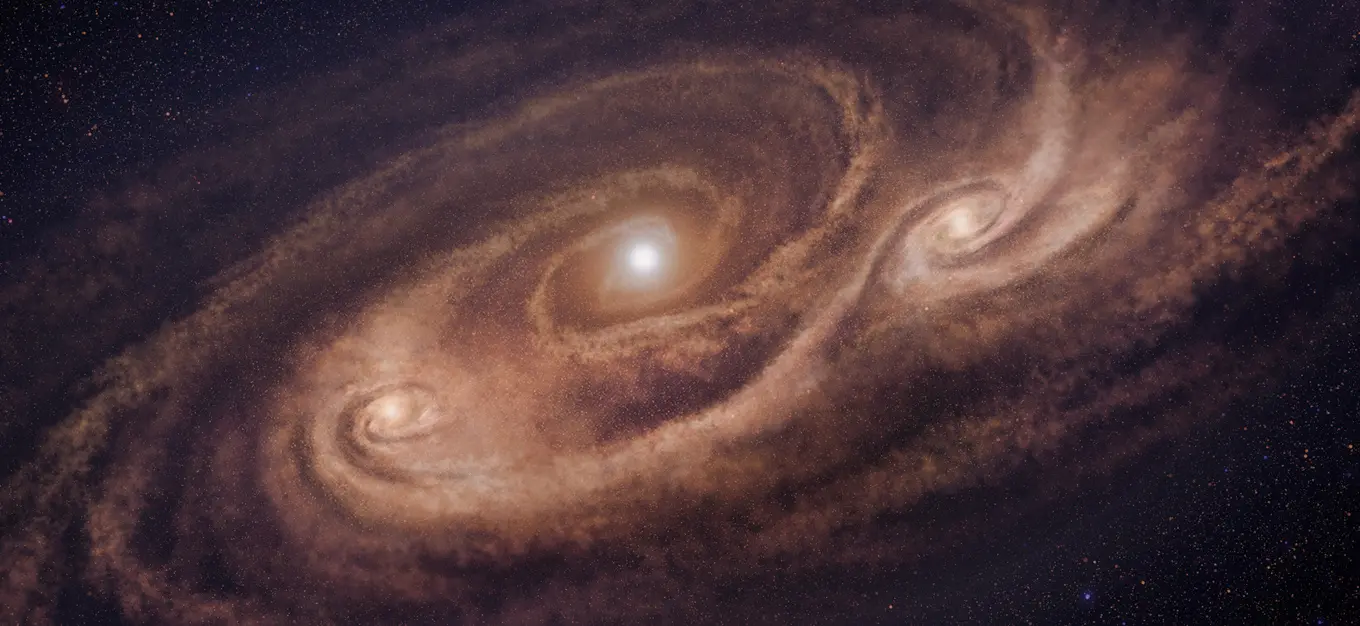ALMA Observed an Unstoppable Monster in the Early Universe
Astronomers obtained the most detailed anatomy chart of a monster galaxy located 12.4 billion light-years away. Using the Atacama Large Millimeter/submillimeter Array (ALMA), the team revealed that the molecular clouds in the galaxy are highly unstable, which leads to runaway star formation. Monster galaxies are thought to be the ancestors of the huge elliptical galaxies in today’s Universe; therefore, these findings pave the way to understand the formation and evolution of such galaxies.
“One of the best parts of ALMA observations is to see the far-away galaxies with unprecedented resolution,” says Ken-ichi Tadaki, a postdoctoral researcher at the Japan Society for the Promotion of Science and the National Astronomical Observatory of Japan, lead author of the research paper published in the journal Nature.
Monster galaxies, or starburst galaxies, form stars at a startling pace; 1000 times higher than the star formation rate in our Galaxy. However, why are they so active? To tackle this problem, researchers need to know the environment around the stellar nurseries. Drawing detailed maps of molecular clouds is one crucial step to scout these cosmic monsters.
Tadaki and the team targeted a chimerical galaxy COSMOS-AzTEC-1. This galaxy was first discovered with the James Clerk Maxwell Telescope in Hawai`i, and later the Large Millimeter Telescope (LMT) in Mexico found an enormous amount of carbon monoxide gas in the galaxy and revealed its hidden starburst. The LMT observations also measured the distance to the galaxy, and found that it is 12.4 billion light-years [1].
Researchers have found that COSMOS-AzTEC-1 is rich with the ingredients of stars, but it was still difficult to figure out the nature of the cosmic gas in the galaxy. The team utilized the high resolution and high sensitivity of ALMA to observe this monster galaxy and obtain a detailed map of the distribution and the motion of the gas. Thanks to the most extended ALMA antenna configuration of 16 km, this is it the highest resolution molecular gas map of a distant monster galaxy.
“We found that there are two distinct large clouds several thousand light years away from the center,” explains Tadaki. “In most distant starburst galaxies, stars are actively formed in the center. So, it is surprising to find off-center clouds.”

Monster galaxy COSMOS-AzTEC-1 observed with ALMA. ALMA revealed the distribution of molecular gas (left) and dust particles (right). In addition to the dense cloud in the center, the research team found two dense clouds several thousand light-years away from the center. These dense clouds are dynamically unstable and thought to be the sites of intense star formation. Credit: ALMA (ESO/NAOJ/NRAO), Tadaki et al.
The astronomers further investigated the nature of the gas in COSMOS-AzTEC-1 and found that the clouds throughout the galaxy are very unstable, which is unusual. In a typical situation, the inward gravity and outward pressure are balanced in the clouds. Once gravity overcomes pressure, the gas cloud collapses and forms stars at a rapid pace. Then, stars and supernova explosions at the end of the stellar life cycle blast out gases, which increases the outward pressure. As a result, gravity and pressure reach a balanced state and star formation continues at a moderate pace. In this way star formation in galaxies is self-regulating. However, in COSMOS-AzTEC-1, the pressure is far weaker than the gravity and hard to balance. Therefore, this galaxy shows runaway star formation and morphed into an unstoppable monster galaxy.
The team estimated that the gas in COSMOS-AzTEC-1 will be completely consumed in 100 million years, which is ten times faster than in other star-forming galaxies.
However, why is the gas in COSMOS-AzTEC-1 so unstable? Researchers do not have a definitive answer yet, but galaxy merger is a possible cause. Galaxy collision may have efficiently transported the gas into a small area and ignited intense star formation.
“At this moment, we have no evidence of merger in this galaxy. By observing other similar galaxies with ALMA, we want to unveil the relation between galaxy mergers and monster galaxies,” summarizes Tadaki.
Notes
[1] The measured redshift of COSMOS-AzTEC-1 is z=4.3. A calculation based on the latest cosmological parameters measured with Planck (H0=67.3 km/s/Mpc, Ωm=0.315, Λ=0.685: Planck 2013 Results) yields the distance of 12.4 billion light-years. Please refer to “Expressing the distance to remote objects” for the details.
Additional Information
These observation results appear as Tadaki et al. “The gravitationally unstable gas disk of a starburst galaxy 12 billion years ago” in Natureon August 30, 2018.
The research team members are:
Ken-ichi Tadaki (Japan Society for the Promotion of Science / National Astronomical Observatory of Japan), Daisuke Iono (National Astronomical Observatory of Japan / SOKENDAI), Min S. Yun (University of Massachusetts), Itziar Aretxaga (Instituto Nacional de Astrofísica, Óptica y Electrónica), Bunyo Hatsukade (The University of Tokyo), David H. Hughes (Instituto Nacional de Astrofísica, Óptica y Electrónica), So Ikarashi (University of Groningen), Takuma Izumi (National Astronomical Observatory of Japan), Ryohei Kawabe (National Astronomical Observatory of Japan), Kotaro Kohno (The University of Tokyo), Munju Lee (Nagoya University), Yuichi Matsuda (National Astronomical Observatory of Japan / SOKENDAI), Kohichiro Nakanishi (National Astronomical Observatory of Japan / SOKENDAI), Toshiki Saito (Max Planck Institute for Astronomy), Yoichi Tamura (Nagoya University), Junko Ueda (National Astronomical Observatory of Japan), Hideki Umehata (RIKEN), Grant W. Wilson (University of Massachusetts), Tomonari Michiyama (SOKENDAI), Misaki Ando (SOKENDAI), Patrick Kamieneski (University of Massachusetts).
This research was supported by JSPS KAKENHI (Grant Number 17J04449).
The Atacama Large Millimeter/submillimeter Array (ALMA), an international astronomy facility, is a partnership of the European Southern Observatory (ESO), the U.S. National Science Foundation (NSF) and the National Institutes of Natural Sciences (NINS) of Japan in cooperation with the Republic of Chile. ALMA is funded by ESO on behalf of its Member States, by NSF in cooperation with the National Research Council of Canada (NRC) and the Ministry of Science and Technology (MOST) in Taiwan and by NINS in cooperation with the Academia Sinica (AS) in Taiwan and the Korea Astronomy and Space Science Institute (KASI).
ALMA construction and operations are led by ESO on behalf of its Member States; by the National Radio Astronomy Observatory (NRAO), managed by Associated Universities, Inc. (AUI), on behalf of North America; and by the National Astronomical Observatory of Japan (NAOJ) on behalf of East Asia. The Joint ALMA Observatory (JAO) provides the unified leadership and management of the construction, commissioning and operation of ALMA.
Contacts
-
Nicolás Lira
Education and Public Outreach CoordinatorJoint ALMA Observatory, Santiago - ChilePhone: +56 2 2467 6519Cel: +56 9 9445 7726Email: [email protected] -
Masaaki Hiramatsu
Education and Public Outreach Officer, NAOJ Chile -
Charles E. Blue
Public Information OfficerNational Radio Astronomy Observatory Charlottesville, Virginia - USAPhone: +1 434 296 0314Cel: +1 202 236 6324Email: [email protected] -
Calum Turner
ESO Assistant Public Information Officer


